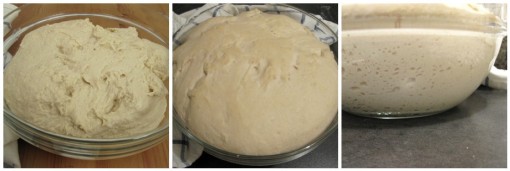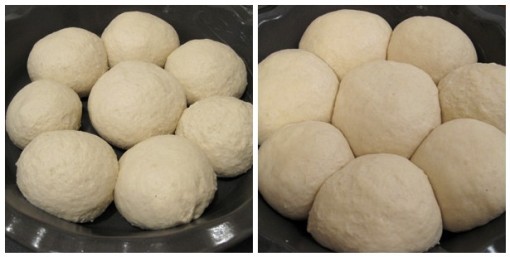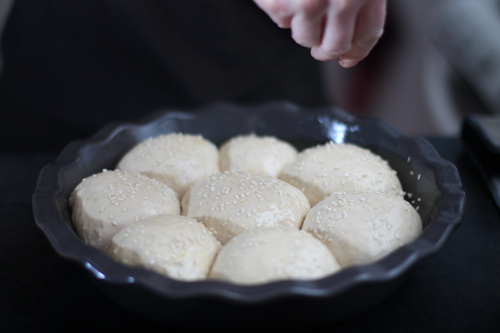To answer the age-old question, “Why on Earth would you bother baking bread when you live in Paris?” I say, first, “Because I enjoy it,” and second, “Because it’s something I can’t buy here.” Like jalapeño-cheese bread, for example. Or these dinner rolls. Michael Ruhlman posted a recipe for soft, pull-apart, oh-so-American buttermilk dinner rolls a couple of days ago, and since I had just bought a carton of buttermilk for Saturday morning’s carrot cake pancakes, I figured it was a sign. When I told Nick I would be baking some rolls for dinner on Saturday, and asked him what would go well with rolls, he immediately responded “hot ham water.” Which is what we call Fergus Henderson‘s boiled ham with parsley sauce – a recipe that sounds horribly English in the worst way, but is actually so simple and so delicious (and you get leftover ham for sandwiches and the leftover stock for cooking beans!) that it became an instant classic in our kitchen.
But I was talking about rolls. Ruhlman developed his recipe based on one from Saveur magazine, because he didn’t like the volume measurements and wanted to do it by weight. I agree with him 100% – baking by weight is far more accurate and likely to produce consistent results than baking by volume, plus there’s the added bonus of not having to fuss around with measuring cups, the dipping and sweeping and getting flour all over the counter.
See? Tidy as can be. Flour, yeast, salt, and honey (I ran out of regular honey making a batch of granola and had to use chestnut honey – life’s rough) weighed straight into the bowl, followed by the buttermilk (which I actually measured out into a separate jug so I could microwave it for 30 seconds to take the chill off).
Seeing as my KitchenAid is tucked safely away in storage at the moment, I mix and knead all the breads I make in my Parisian kitchen by hand. I start with a wooden spoon and proceed to finish mixing and kneading with my hands.

1. Dough, pre-knead, 2. Kneading 1, 3. Kneading 2, 4. Sticky dough
I like to knead the dough right in the bowl for a couple of reasons: one, it keeps the counter clean and all the dough and flour in one place; and two, I can do it one-handed and take pictures with the other hand. Ruhlman’s recipe, which uses a standing mixer, says it will take about 10 minutes of kneading. By hand, it took a little over 15 minutes before I had a relatively smooth mass that passed the windowpane test. I have one little quibble with Ruhlman, though. One of his complaints about the original recipe he followed was that he didn’t know what the dough was supposed to be like when it was ready – soft, firm, sticky, dry? And yet his modified recipe gives no indication, either. While it’s true that using weight measures takes a lot of the guesswork out of baking, there are always the confounding factors of humidity and temperature. I found the dough to be quite sticky, but didn’t add any additional flour because I figured we were going for a soft, airy finished product, and I know that the doughs for softer breads are usually sticky. But then, I’m a pastry chef. The average home baker might not have that knowledge.
Anyway, I transferred the kneaded dough to another bowl (I needed the big one to continue the granola project that I had going simultaneously), covered it with a towel, and set it aside to rise for a little over two hours.

1. Before the rise, 2. After the rise, 3. Bubbly
Proofing in a glass bowl is fun because it allows you to see what’s going on in the dough, like a yeast farm. the top of the dough dried out a bit, but I was ok with that – it wasn’t dry enough to form a skin, and I hoped that the risen dough might be a little less sticky because of it. I scraped the dough out onto the floured countertop, kneaded it a couple times and patted it into a rectangular shape. Despite my love of the scale for mixing, I have very little patience for scaling out dough after it’s mixed. So I eyeballed it, cutting the rectangle into four pieces and dividing each of those into three pieces. As you can see, my rolls were not exactly equal in size, but I wasn’t too worried about it.

I also don’t have a springform pan, so I buttered my ceramic pie dish and placed the rolls in there. There was only room for eight of the twelve rolls, so I nestled the remaining four in a well-greased loaf pan and wrapped it tight before putting them in the freezer for another day. The proofing took a little under the recommended hour – the kitchen was getting warm with the hot ham water on the stove and the oven preheating. At this point, Nick decided to take over the photography responsibilities while I egg washed and sprinkled sesame seeds over the rolls.

And into the oven they went. A couple of other bloggers have already tackled these rolls, and I agree with Dragana that the rolls looked done after 30 minutes, but weren’t. The thermometer not only read about 150F (it’s supposed to be 195-200F), but it came out sticky with dough. I’m not afraid of a nicely browned baked good, though, so I just popped them back in for another 15 minutes or so, until they were done (and the thermometer came out clean).

They smelled heavenly – yeasty and rich, and when I tore into one, the scent of chestnut honey drifted up in a puff of steam. The texture was great, too: puffy and soft, but with a satisfying chew. They made a great side to the ham, and may have been even better this morning, smothered in leftover parsley sauce (à la biscuits and gravy) with sides of sausage and scrambled eggs (which included the leftover egg wash – yay!).
So the good news is that this very American recipe can easily be reproduced with French ingredients in a less-than-ideally equipped kitchen. And any recipe that can stand up to changes in scale and method and still succeed is a good recipe indeed. Thanks, Michael!
Originally published on Croque-Camille.






 Ab
Ab Ac
Ac











Love the look of these and the last picture especially!
The pastry chef where I was chef was a stickler about bakers afraid to brown product. She called them Blonde Bakers! With under baked food, and she was correct!
Gala – Thank you! I like that last one a lot, too – my husband did a great job!
Lynn – Ha! Sounds like a woman after my own heart.
I love the cooking methods employed in this one.
Your last photo is stunning. Wish I had that baking dish cooling on my kitchen counter right now.
I’m with Lynn, Camille. I think most American bakers, or maybe timid bakers, don’t brown their baked goods enough. Your rolls are Gorgeous!
And yay Nick for taking pix for you:)
I think “Because I enjoy it” is a pretty good reason for most things in life 🙂
However, you have caused me to put on my crankypants as I’ve wanted to try chestnut honey for years, and here you are all “oh, it’s my back-up option, ladeedah” 😛
I love your action shots, and the golden burnished final result – beautiful!
Your rolls turned out beautifully. How I wish I could pack up and move to Paris for a few years! Thanks for mentioning my experience. I’ll be checking back to your nice blog again.
[…] are Camille’s gorgeous results at Croque Camille, kneaded by hand, and I love the rise in the glass bowl so you can see how active the dough is. Her […]
one ordinary day – Thank you! We had fun shooting it, and I’m very lucky that here in France you can find beautiful ceramicware for not a lot of money.
pastrychef – I think you’re right about the timid part. Many people don’t realize the benefits of really letting things brown.
Hannah – The funny thing is, I kind of hoard my fancy honeys and was loath to use it, but now I know that the flavor can withstand baking, so yay! And now I know EXACTLY which chocolaterie I want to take you to when you get here…
Dragana – Thank you. I feel very lucky to be here – it is a wonderful adventure.
What a fabulous post! I am so intimidated by bread baking and here you are, swapping chestnut honey and kneading one-handed. Very impressive! These rolls are absolutely stunning and as you say, quintessentially American.
Hot ham water. Love it! Those rolls, oh my. Stunning photography and baking again!
*claps hands like a giddy little schoolgirl*
That is all.
hungry dog – Thank you! See, yeast baking is nothing to be afaraid of. 🙂
Ryan – Just a little something for the Arrested Development fans out there.
Hannah – 😀
STEVE HOLT!!
(And now I will stop hijacking your post :P)
These look amazing! Thanks for sharing 🙂
Hannah – *pumps fists in the air*
Karine – Thank you, and you’re welcome!